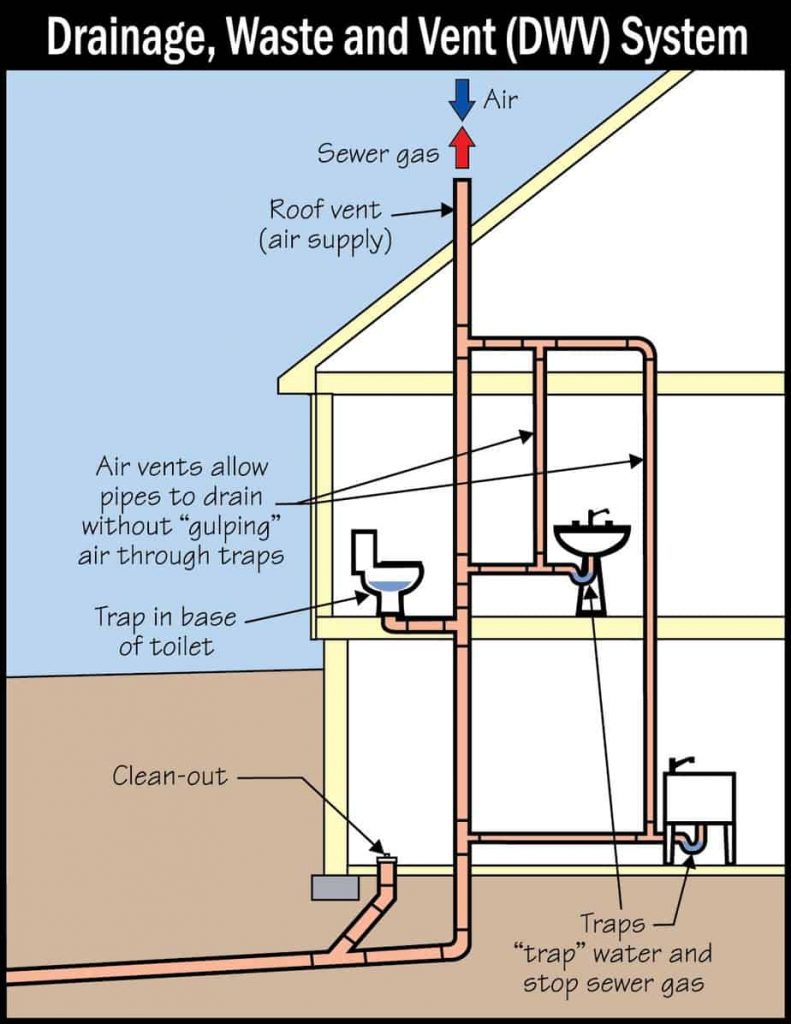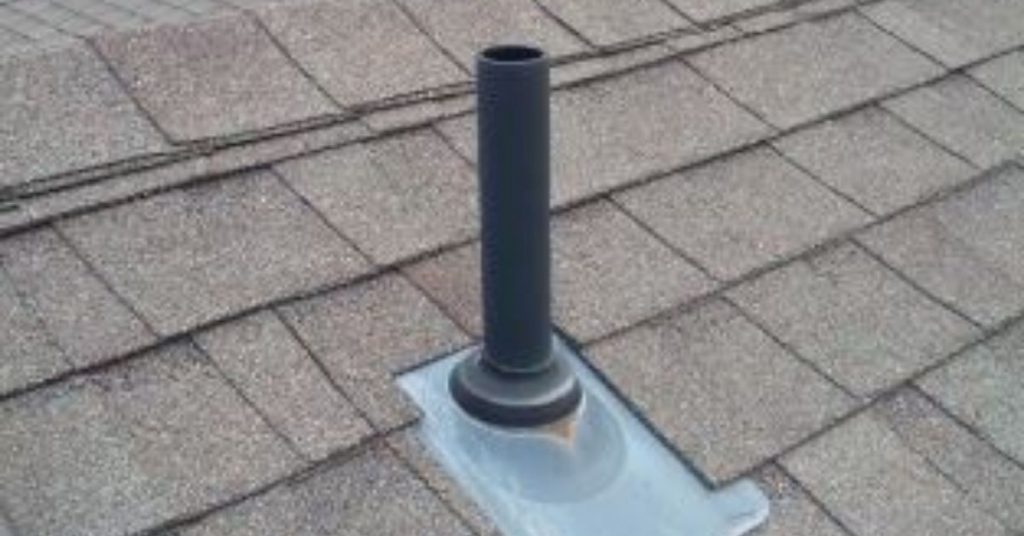A plumbing vent is vertical piece of pipe connected to the main house drain line and which runs through the roof of the house. It is one of the main components of the drain-waste-vent system.

Unclogging a plumbing vent is essential to ensure proper drainage and prevent sewer gas buildup in your plumbing system. Here’s a brief summary of the correct steps to unclog a plumbing vent:
- Safety First: Wear appropriate protective gear, such as gloves and eye protection, to prevent contact with debris and wastewater.
- Locate the Vent: Identify the location of the clogged vent pipe on your roof or exterior wall. Be cautious when climbing to access it.
- Inspect for Debris: Visually inspect the vent for any visible obstructions, such as leaves, bird nests, or debris. Remove any blockages using a gloved hand or a plumbing snake.
- Use a Plumbing Snake: If the clog is deeper within the vent, use a plumbing snake or auger to reach it. Insert the snake into the vent and rotate it while applying gentle pressure to break up and dislodge the clog.
- Flush with Water: After clearing the obstruction, flush the vent with a hose or bucket of water to ensure proper flow and confirm that the clog is fully removed.
- Check for Proper Ventilation: Confirm that the plumbing vent is functioning correctly by observing improved drainage and reduced gurgling noises in drains and toilets.
- Prevent Future Clogs: Install a vent cap or screen to prevent debris from entering the vent pipe in the future. Regular maintenance can also help prevent future clogs.
- Safety Precautions: Always exercise caution when working on rooftops or using plumbing tools. If the clog is extensive or inaccessible, consider hiring a professional plumber to address the issue safely.
How a Plumbing Vent Works

Every fixture in your house has its own separate drain line. All these drain lines are then connected to the main house drain line which is a large vertical pipe that drains to the sewer line outside the house.
A plumbing vent is the vertical section of pipe connected to the main drain above the fixture at the highest level and runs through the roof of the house. All the fixtures are also connected to the plumbing vent.
Now, if you look underneath your kitchen or bathroom sink, you will see that the drain line is U-shaped. That is what is called a P-trap.
A P-trap is always full of water. That is why there is water at the bottom of your toilet bowl. All fixtures including tubs and washing machines have P-traps.
The water in the P-trap acts as a barrier, preventing sewer gases from coming up through the drains. Instead, the sewer gases are forced out through the plumbing vent.
Another function of a plumbing vent is to introduce air into the drain lines. This helps the fixtures drain faster and toilets flush strongly.
In order for fixtures to drain efficiently and toilets to flush normally, there needs to be air in the drain lines and not a vacuum. This is why if you punch a hole in a water bottle and remove the lid it will drain out faster than a bottle without a hole.
In simpler terms, a plumbing vent equalizes pressure inside and outside the drain lines.
Symptoms of a Clogged Plumbing Vent
So, how do I know if my plumbing vent is clogged? The following are the tell tale signs that your plumbing vent is clogged:
1. Slow Drains and Weak Flushing Toilets
Slow Drains and slow flushing toilets are often caused by a clogged plumbing vent. They can however also be caused by a clogged main drain line or even sewer line.
A clogged plumbing vent creates pressure imbalance between the inside and outside of the drain lines which restricts the drains resulting in slow draining fixtures. In the case of toilet you will notice water filling the bowl and then draining out slowly, without even flushing out the waste.
2. Gurgling Drains
Have you ever heard the bathtub/shower drain gurgling after flushing the toilet, bathroom sink drain gurgling after flushing the toilet or kitchen sink drain gurgling when the washing machine is draining?
What usually happens in that case is that because the plumbing vent is clogged, as water drains out of one fixture, it creates a vacuum inside the drain line.
Since vacuums fight hard to exist, the vacuum siphons out of the nearby drain’s P-trap. It is the process of sucking water from adjacent P-traps that causes the gurgling sound.
3. Sewer Smell in the House
As I had mentioned, the water in the P-trap acts as a barrier preventing sewer gases from entering the house through the drains. When drains gurgle, it means the water in the P-traps has been siphoned out and the traps are empty.
With a clogged plumbing vent and empty P-traps, sewer gases will flow into the house unrestricted.
How to Clear a Clogged Plumbing Vent

Here is how to unclog a plumbing vent:
- Climb to the roof of the house armed with a garden hose. As you climb, have a helper hold down the ladder to prevent it from slipping. Wear slip-resistant shoes or avoid doing it when the roof is too slippery as a result of bad weather.
- Remove the vent cap if there is one.
- Stick your hand inside the vent stack and try to feel if there is anything inside. If there is pull it out.
- Insert the garden house inside the vent until you encounter some resistance.
- Probe through the resistance and see if you will manage to break it or force it down.
- Have your helper turn on the water to the garden hose. The weight of the water is in most cases sufficient to dislodge and flush the clog down the drain.
- If instead the vent fills with water, it means the clog is quite nasty. You will need to upgrade to a better tool.
- Let your helper hand you the plumber’s snake and slowly feed it down the vent stack until you encounter the resistance.
- Lock the cable and start cranking the handle clockwise in a bid to break down the clog. Remember the cable should rotate but not twist. If it starts to twist change the direction of turning then start again.
- When you have finally broken the clog, release more cable into the stack to check if there are more clogs.
- Place the palm of your hand at the top of the vent and have the helper flush the toilet. If there is suction underneath then the vent is now clear.
Pro tip: During the winter, it is not unusual for the vent to be clogged by snow. If that is the case, connect a hose (rated for use with hot water) to your washing machine hot water spigot then insert it in the vent. The hot water will melt the snow and effectively unclog the vent.
How to Unclog a Plumbing Vent without Going on the Roof
If you don’t feel like climbing to the roof of the house, there is another method you can use to unclog the plumbing vent. It is however more work and may involve a trip to the plumbing store.
Note: This method will only work if you have a PVC plumbing vent and not a cast iron one.
Here is how to do it:
- Climb to your attic. The plumbing vent passes through your attic.
- Locate the vent stack.
- Use a hacksaw to cut out a section of the vent stack. The section should be enough to fit a plumbing snake.
- Feed the plumbing snake through the opening until you get to the clog. Crank the handle back and forth until you break down the clog.
- With the vent clog cleared, it is now time to patch up the opening. For this, you will a pipe coupling of the same diameter as the vent an long enough to cover the cut section.
- Since the ends of the pipes will most likely be burred, use a utility knife or file to smoothen them.
- Apply PVC glue or cement on both ends of the vent pipe and coupling.
- Install the pipe coupling.
And basically that is how to clear a clogged plumbing vent. I hope this guide was helpful.






